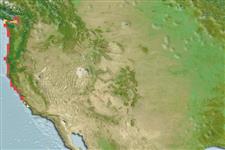>
Ovalentaria/misc (Various families in series Ovalentaria) >
Embiotocidae (Surfperches)
Etymology: Amphistichus: Greek, amphi = on both sides + Greek, stix, -ichos = row (Ref. 45335); rhodoterus: From 'rodoteros' meaning rosy (Ref. 6885).
More on author: Agassiz.
Environment: milieu / climate zone / depth range / distribution range
Ecología
marino; salobre demersal; rango de profundidad 0 - 7 m (Ref. 2850). Temperate; 50°N - 34°N, 126°W - 119°W
Eastern Pacific: Vancouver Island, British Columbia, Canada to Avila Beach, central California, USA.
Tamaño / Peso / Age
Maturity: Lm ? range ? - ? cm
Max length : 41.0 cm TL macho / no sexado; (Ref. 2850); edad máxima reportada: 9 años (Ref. 56049)
Espinas dorsales (total): 9 - 10; Radios blandos dorsales (total): 25-28; Espinas anales 3; Radios blandos anales: 28 - 31. Caudal fin broadly forked (Ref. 6885). Generally silvery overlaid lightly with a brassy cast; light green above; sides with a series of about 9 to 11 narrow vertical dark bars, posteriorly, broken and staggered along the lateral line; caudal and anal fins red (Ref. 6885).
Adults are found in sand beaches in surf on exposed coast, sometimes in bays and backwaters (Ref. 2850). Viviparous, female carries the developing young (Ref. 205).
Life cycle and mating behavior
Madurez | Reproducción | Puesta | Huevos | Fecundidad | Larva
Viviparous, female carries the developing young (Ref. 205).
Eschmeyer, W.N., E.S. Herald and H. Hammann, 1983. A field guide to Pacific coast fishes of North America. Boston (MA, USA): Houghton Mifflin Company. xii+336 p. (Ref. 2850)
IUCN Red List Status (Ref. 130435)
Threat to humans
Harmless
Human uses
Pesca deportiva: si; Acuario: Acuarios públicos
Más información
ReferenciasAcuiculturaPerfil de acuiculturaRazasGenéticaElectrophoresesheritabilidadEnfermedadesProcesamientoNutrientsMass conversion
Herramientas
Special reports
Download XML
Fuentes de Internet
Estimates based on models
Preferred temperature (Ref.
123201): 10.3 - 14, mean 12.1 °C (based on 57 cells).
Phylogenetic diversity index (Ref.
82804): PD
50 = 0.6250 [Uniqueness, from 0.5 = low to 2.0 = high].
Bayesian length-weight: a=0.01445 (0.00872 - 0.02396), b=3.00 (2.85 - 3.15), in cm total length, based on LWR estimates for this species & (Sub)family-body (Ref.
93245).
Nivel trófico (Ref.
69278): 3.4 ±0.5 se; based on diet studies.
Resiliencia (Ref.
120179): Medio, población duplicada en un tiempo mínimo de 1.4-4.4 años (tm=3; tmax=9; Fec=39).
Fishing Vulnerability (Ref.
59153): Low to moderate vulnerability (31 of 100).
